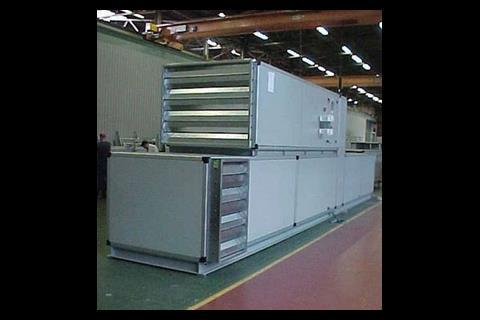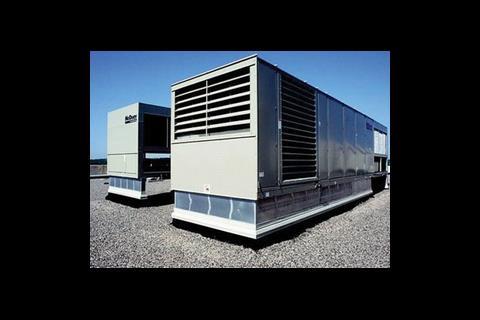This month, Davis Langdon considers the implications of Part L, with its emphasis on energy use of building services equipment, on specifying air handling units
The arrival of the new Part L this year and the emphasis it places on energy usage of building services equipment means that fan electrical power is now one of the key factors in plant selection.
What used to be a relatively straightforward process has now become much more complicated, with careful consideration required from the designer regarding the static pressures throughout the air system. However, with the use of the most appropriate fan, the energy savings should be considerable.
In the case of AHUs, fan electrical power is now a maximum of 2.5 W/l/s. The optimum AHU design solution involves the selection of several key factors: air volume, heating/cooling requirements, space availability and noise levels – consequently, the final design will be the product of a complex balancing act involving performance issues, space requirements and capital cost.
In this cost model, the key design criteria are examined, with selection of components to ensure that the air handling unit meets Part L requirements. However, it is worth noting that the comparisons given here refer to the AHUs only, and do not cover the complete ventilation system.
Key selection criteria
The material specification of AHUs must be examined to identify areas that can impact on the physical materials of construction and capital cost of the unit. Performance specification mustalso be checked to determine the working limits of componenets, and whether non-standard components are required
Specification
The tailoring of AHUs to project set requirements can lead to a significant variation in unit construction, size and specification.
Once a complete specification is available, the selection and pricing of units can be undertaken accurately, but in the absence of full specification details, it is possible to design a set of templates for standard applications, which detail typical solutions for fresh air and return air units, and supply and extract units. These can provide relatively accurate costing for different duties at an early stage of design.
Air handling units are high energy users and their specification will have a significant impact on the total energy consumption of a building.
For example, AHUs serving four-pipe fan coil systems, which are typically supplied with minimum fresh air, are one of the highest users of energy in an office building. The consideration of energy reclaim through recuperators and high efficiency motors to fans is therefore particularly important.
The increased cost of gas, by 50%, and electricity, by 25%, over the last 10 years, makes it even more imperative that energy reclaim forms part of the initial selection of plant. The different types of recuperators (plate heat exchanger, thermal wheel and run-around coil) vary in size, efficiency and cost, so when specifying a recuperator system, the additional energy consumption due to running the system must also be considered.
Additional energy loads include increased fan motor power in the AHU and increased pump motor power with the run-around coil, or as in this case, motor power to the thermal wheel. The selection of a thermal wheel means that the AHU will become physically larger in order to accommodate it and keep the air pressure drop as low as possible, thus resulting in less absorbed fan power. The result, however, is a unit that could cost some 10-15% more because of these two factors.
The fan selection process
The selection process is currently very much an iterative one.
Initially the design criteria are entered; flow rate, total static resistance, discharge velocity, quantity of velocity pressures required, and required w/l/s rate. This will calculate a maximum system input power permitted to achieve the required w/l/s rate, together with nominal required total system efficiency.
If the nominal system efficiency required to meet the pressure requirement exceeds 100% then clearly the design requirements are not physically possible, and the system needs to be reviewed in terms of the working static pressure.
Figures of around 60% for low velocity systems, 70% on medium volume systems, and up to 80% on high volume systems (with careful selection of fanset components) mean that the fan selection for the system design should comply with the required w/l/s rate.
The actual fan selection can then be confirmed. From the fan selected, the actual dynamic pressure, fan shaft power, and all fields down to inverter efficiency are entered.
In order to select the most efficient fan, thus giving the greatest chance of complying with the required w/l/s rate, care needs to be taken with selection of all components, for instance using high efficiency belts or better still, a direct drive fan, eliminating belt losses altogether. With the full load on the motor (including drive losses), the motor efficiency can be obtained.
From the above data, the total system input power is calculated, including all system losses (fan, drive, motor, inverter), and from that the w/l/s rate of the system, and the system total efficiency. If the w/l/s rate is less than the design rate, then the requirements are satisfied. If not, then the design needs to be reviewed in terms of the reselection of the fan components to improve total efficiency eg switch to direct drive (eliminating belt drive losses), use premium efficiency motors, select more efficient fan size, consider changing to an alternative fan type. Another option is to redesign the system, allowing larger duct diameters, lower resistance ductwork, lower resistance AHU components etc (larger AHU).
To assist in giving a guideline as to how far out the selection is from complying, a nominal max static pressure and total pressure is calculated at the bottom of the page. This is based on the efficiency of the selected components and the w/l/s rate specified.
Typical example
The table on the right shows a typical AHU which has a 22 m3/s supply with 17.1 m3/s extract and depicts the fan/system efficiencies for both the supply and extract fan sections when using a thermal wheel with an efficiency of about 70% as it’s recuperator. It also shows the air pressure drop values for the various components used; these efficiencies do not take into account the above stated additional energy loads required to operate them.
The result shows that with the correct selection of fan motors and recuperator, the fan power absorbed is 2.373 W/l/s, which is within the maximum of 2.5 W/l/s as required by Part L 2006.
Source
Building Sustainable Design
























No comments yet